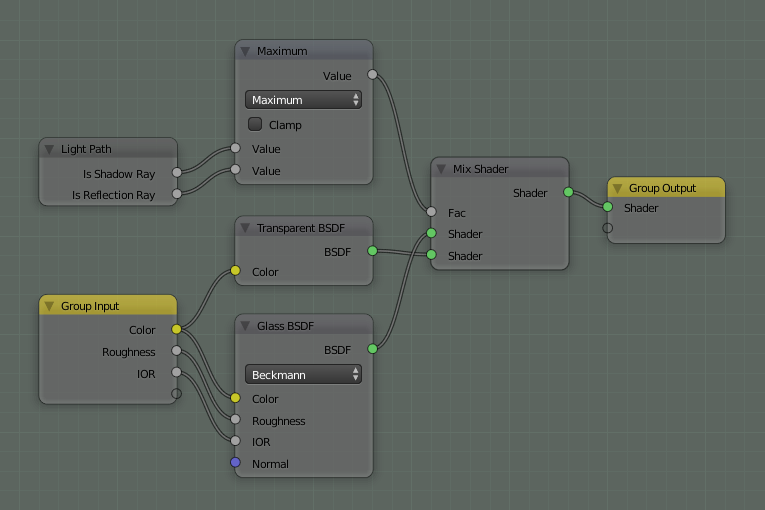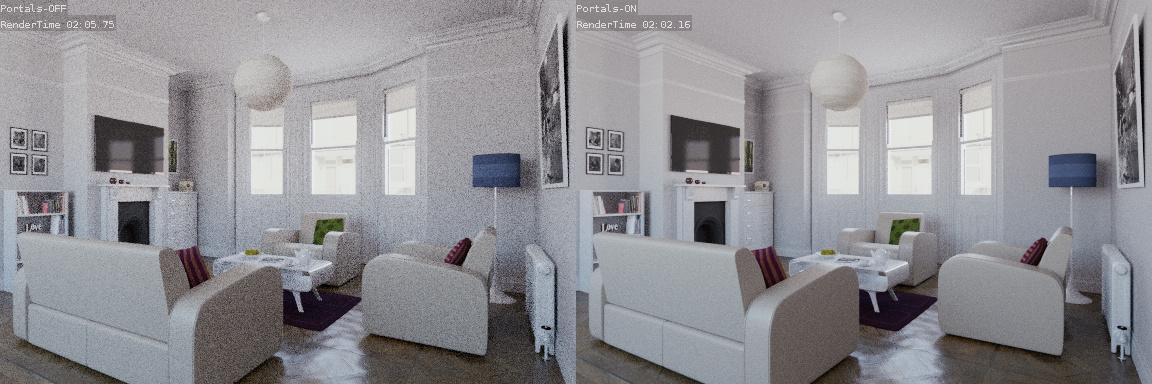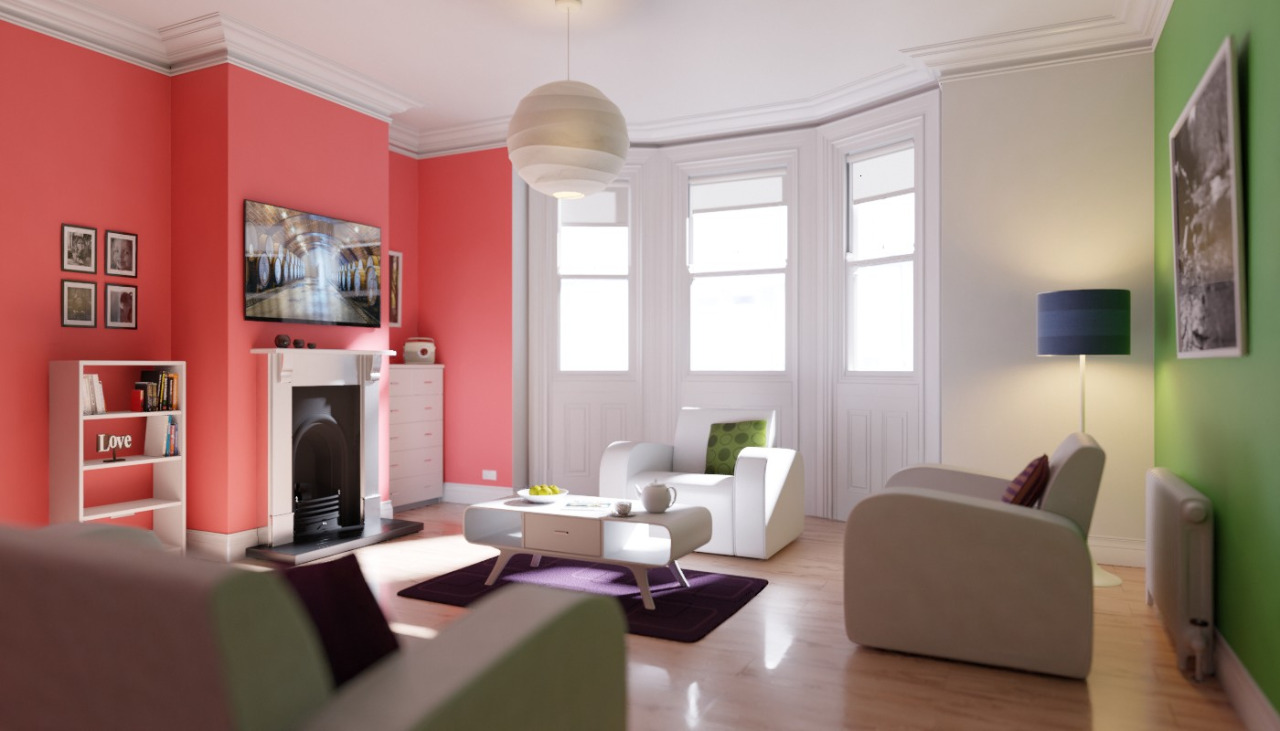降噪
Cycles uses path tracing with next event estimation,which is not good at rendering all types of light effects, like caustics,but has the advantage of being able to render more detailed andlarger scenes compared to some other rendering algorithms.This is because we do not need to store,for example, a photon map in memory,and because we can keep rays relatively coherent to use an on-demand image cache,compared to e.g. bidirectional path tracing.
We do the inverse of what reality does,tracing light rays from the camera into the scene and onto lights,rather than from the light sources into the scene and then into the camera.This has the advantage that we do not waste light rays that will not end up in the camera,but also means that it is difficult to find some light paths that may contribute a lot.Light rays will be sent either according to the surface BRDF,or in the direction of known light sources.
See also
For more details, seethe andSampling documentation.
Where Noise Comes From
To understand where noise can come from, take for example the scene below.When we trace a light ray into the location marked by the white circle on a red dot,the second image below gives an impression of what the diffuse shader "sees".
To find the light that is reflected from this surface,we need to find the average color from all these pixels.Note the glossy highlight on the sphere,and the bright spot the light casts on the nearby wall. These hotspots are 100x brighter thanother parts of the image and will contribute significantly to the lighting of this pixel.
The light is a known light source, so its location is already known,but the glossy highlight(s) that it causes are a different matter.The best we can do with path tracing is to distribute light rays randomly over the hemisphere,hoping to find all the important bright spots. If for some pixels we miss some bright spot,but we do find it for another, that results in noise. The more samples we take,the higher the probability that we cover all the important sources of light.
With some tricks we can reduce this noise. If we blur the bright spots,they become bigger and less intense, making them easier to find and less noisy.This will not give the same exact result,but often it's close enough when viewed through a diffuse or soft glossy reflection.Below is an example of using and Light Falloff.
| Using Glossy Filter & Light Falloff. | Irradiance at the shading point. | The detected highlights. |
Bounces
| No bounces. | Two bounces at max. | Four bounces at max. |
Also important is to use shader colors that do not have components of value 1.0 orvalues near that; try to keep the maximum value to 0.8 or less and make your lights brighter.In reality, surfaces are rarely perfectly reflecting all light,but there are of course exceptions; usually glass will let most light through,which is why we need more bounces there. High values for the color components tend tointroduce noise because light intensity then does not decrease much as it bounces off eachsurface.
Caustics are a well-known source of noise, causing fireflies.They happen because the renderer has difficulty finding specular highlightsviewed through a soft glossy or diffuse reflection.There is a option to disable glossy behind a diffuse reflection entirely.Many renderers will typically disable caustics by default.
However, using No Caustics will result in missing light,and it still does not cover the case where a sharp glossy reflection is viewed through a soft glossy reflection.There is a Filter Glossyoption to reduce the noise from such cases at the cost of accuracy.This will blur the sharp glossy reflection to make it easier to find, by increasing the shader Roughness.
The above images show default settings, no caustics, and filter glossy set to 1.0.
Light Falloff
In reality light in a vacuum will always fall off at a rate of 1/(distance^2).However, as distance goes to zero,this value goes to infinity and we can get very bright spots in the image.These are mostly a problem for indirect lighting, where the probability of hitting sucha small but extremely bright spot is low and so happens only rarely.This is a typical recipe for fireflies.
| Hard Falloff. | Soft Falloff. |
To reduce this problem, the node has a Smooth factor, that can be used to reduce the maximum intensitya light can contribute to nearby surfaces. The images above show default falloff and smooth value 1.0.
Multiple Importance Sampling
Materials with emission shaders can be configured to useMultiple Importance Sampling (材质设置).This means that they will get rays sent directly towards them,rather than ending up there based on rays randomly bouncing around.For very bright mesh light sources, this can reduce noise significantly.However, when the emission is not particularly bright,this will take samples away from other brighter light sources for which it is important to find them this way.
The optimal setting here is difficult to guess; it may be a matter of trial and error,but often it is clear that a somewhat glowing object may be only contributing light locally,while a mesh light used as a light would need this option enabled.Here is an example where the emissive spheres contribute little to the lighting,and the image renders with slightly less noise by disabling Multiple Importance on them.
| Multiple Importance off. | Multiple Importance on. |
The world background also has a Multiple Importance () option.This is mostly useful for environment maps that have small bright spots in them, rather than being smooth.This option will then, in a preprocess, determine the bright spots, and send light rays directly towards them. Again,enabling this option may take samples away from more important light sources if it is not needed.
 Optimized glass shader.
Optimized glass shader.
Above we can see the node setup used for the glass transparency trick;on the left the render has too much shadow due to missing caustics,and on the right the render with the trick.
Light Portals
When rendering a daylight indoor scene where most of the light is coming in through a windowor door opening, it is difficult for the integrator to find its way to them.To fix this, use Light Portals.You then will need to modify its shape to match that of the opening that you are trying to fill.

Denoising
Even with all the settings described above there will always endup being some render noise no matter how many samples you use.To fix this there is a post-processing technique to cleanup the final bit of noise.To use this enable in the Render Layers tab of the Properties editor.
Below is an example render byThe Pixelary.
| Example render before denoising. |  Example render after denoising. Example render after denoising. |
Ideally with all the previous tricks, fireflies would be eliminated, but they could still happen. For that,the intensity that any individual light ray sample will contribute to a pixel can be _clamped_to a maximum value with the integrator .
If set too low this can cause missing highlights in the image,which might be useful to preserve for camera effects such as bloom or glare.To mitigate this conundrum it's often useful to clamp only indirect bounces,leaving highlights directly visible to the camera untouched.
| No Clamp (0). | With Clamp set to 4. |


